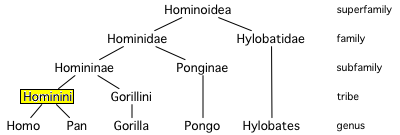사람속
(
Homo
)은
現生人類
와 그 直系 祖上을 包含하는 分類이다. 사람속은 約 250萬年 前에 登場하여,
호모 河빌리스
(
Homo habilis
)의 登場과 함께
오스트랄로피테신
(Australopithecine)의 先祖로부터 進化한 것으로 推定되고 있다. 사람속(
Homo
)의 登場과
올도완 文化
(Oldowan industry)에 屬하는
石器
가 登場한 時期가 一致하며, 이는
前期 舊石器 時代
의 始作으로 定義된다.
호모 사피엔스
(現世 人類)를 除外한 모든 종들은 滅種했다. 傳統的으로는
호모 네안데르탈레시스
(
Homo neanderthalensis
)가 2萬 4千年 前에 滅種하여, 가장 最近까지 現存한 種으로 알려져 왔으나 最近에 發表된 硏究들은 1萬 2千年 前까지 生存한
호모 플로레시엔시스
(
Homo floresiensis
)를 가장 最近에 滅種한 種으로 보고 있다.
 現存하는 類人猿의 系統 分期도
現存하는 類人猿의 系統 分期도
現在까지 드러난 많은 數의 形態學的인 類似性을 勘案하면, 사람속(
Homo
)은 滅種된 사람族(hominin)의 여러 속, 特히
케냔트로푸스속
(
Kenyanthropus
)과
파란트로푸스속
(
Paranthropus
) 그리고
오스트랄로피테쿠스속
(
Australopithecus
)과 매우 密接한 關係를 지니고 있다. 2007年까지는, 사람속(
Homo
)의 起源으로써 普遍的으로 받아들여지고 있는 分類는 없다.
種
[
編輯
]
사람속
種 比較 票
보기
?
討論
?
編輯
?
歷史
| 種
|
生存 時期
(百萬年)
|
生存 場所
|
키(成人)
|
몸무게(成人)
|
頭蓋骨 容量(cm³)
|
化石 記錄
|
發見 / 出版
|
호모 河빌리스
(사람속 종인지 不明確)
|
2.3?1.5
|
탄자니아
|
110?140 cm
|
33?55 kg
|
510?660
|
多數
|
1960
1964
|
호모 壘돌펜시스
(사람속 종인지 不明確)
|
1.9
|
케냐
|
|
|
700
|
2곳
|
1972
1986
|
| 호모 에렉투스
|
1.9?0.14
[1]
[a]
|
아프리카
,
유라시아
|
180 cm
|
60 kg
|
850(初期)?1,100(後記)
|
多數
|
1891
1892
|
| 호모 에르가스테르
|
1.8?1.3
[4]
|
東아프리카
,
南아메리카
|
|
|
700?850
|
多數
|
1949
1975
|
| 호모 안테歲소르
|
1.2?0.8
|
西유럽
|
175 cm
|
90 kg
|
1,000
|
2곳
|
1994
1997
|
| 호모 헤이델베르겐시스
|
0.6?0.3
|
유럽
,
아프리카
|
180 cm
|
90 kg
|
1,100?1,400
|
多數
|
1907
1908
|
| 호모 歲프렌시스
|
c. 0.45
|
이탈리아
|
|
|
1,000
|
頭蓋骨 1點
|
1994
2003
|
| 호모 로데視엔시스
|
c. 0.3
|
잠비아
|
|
|
1,300
|
極少數
|
1921
1921
|
| 호모 날레디
|
c. 0.3
|
南아메리카 共和國
|
150 cm
|
45 kg
|
450
|
15名
|
2013
2015
|
| 호모 네안데르탈렌시스
|
0.35?0.03
|
유럽
,
西아시아
|
170 cm
|
55?70 kg
|
1,200?1,900
|
多數
|
1829
1864
|
| 호모 데니小반스
|
0.04
|
알타이 地方
|
|
|
|
1곳
|
2010
|
호모 사피엔스 사피엔스
(
現生人類
)
|
0.35?現在
|
全 世界
|
140?190 cm
|
50?100 kg
|
1,000?1,850
|
現存
|
?
1758
|
| 호모 사피엔스 이달투
|
0.16?0.15
|
에티오피아
|
|
|
1,450
|
頭蓋骨 3點
|
1997
2003
|
| 호모 플로레시엔시스
|
0.10?0.012
|
인도네시아
|
100 cm
|
25 kg
|
400
|
7名
|
2003
2004
|
| 붉은사슴동굴인
|
|
中國
|
|
|
|
1名
|
2012
|
各州
[
編輯
]
- ↑
Haviland, William A.; Walrath, Dana; Prins, Harald E.L.; McBride, Bunny (2007).
《Evolution and Prehistory: The Human Challenge》
8板. Belmont, CA: Thomson Wadsworth. 162쪽.
ISBN
978-0-495-38190-7
.
- ↑
Ferring, R.; Oms, O.; Agusti, J.; Berna, F.; Nioradze, M.; Shelia, T.; 外. (2011).
“Earliest human occupations at Dmanisi (Georgian Caucasus) dated to 1.85?1.78 Ma”
. 《Proceedings of the National Academy of Sciences》
108
(26): 10432?10436.
Bibcode
:
2011PNAS..10810432F
.
doi
:
10.1073/pnas.1106638108
.
PMC
3127884
.
PMID
21646521
.
- ↑
Indriati, E.; Swisher, C.C. III; Lepre, C.; Quinn, R.L.; Suriyanto, R.A.; 外. (2011).
“The age of the 20 meter Solo River terrace, Java, Indonesia and the survival of Homo erectus in Asia”
. 《PLoS ONE》
6
(6): e21562.
doi
:
10.1371/journal.pone.0021562
.
PMC
3126814
.
PMID
21738710
.
- ↑
Hazarika, Manjil (2007).
〈
Homo erectus/ergaster
and Out of Africa: Recent Developments in Paleoanthropology and Prehistoric Archaeology〉
(PDF)
. 《EAA Summer School eBook》
1
. European Anthropological Association. 35?41쪽.
Intensive Course in Biological Anthrpology, 1st Summer School of the European Anthropological Association, 16?30 June, 2007, Prague, Czech Republic
- ↑
H. erectus
may have appeared some 2 million years ago. Fossils dated to as much as 1.8 million years ago have been found both in Africa and in Southeast Asia, and the oldest fossils by a narrow margin (1.85 to 1.77 million years ago) were found in the Caucasus, so that it is unclear whether
H. erectus
emerged in Africa and migrated to Eurasia, or if, conversely, it evolved in Eurasia and migrated back to Africa.
[2]
Homo erectus soloensis
, found in Java, is considered the latest known survival of
H. erectus
. Formerly dated to as late as 50,000 to 40,000 years ago, a 2011 study pushed back the date of its extinction of
H. e. soloensis
to 143,000 years ago at the latest, more likely before 550,000 years ago.
[3]
外部 링크
[
編輯
]
 위키미디어 公用에
사람속
關聯 미디어 分類가 있습니다.
위키미디어 公用에
사람속
關聯 미디어 分類가 있습니다.
 위키生物種에
Homo
關聯 資料가 있습니다.
위키生物種에
Homo
關聯 資料가 있습니다.